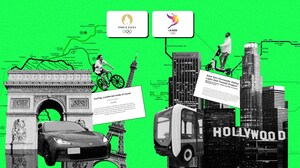Bluedot Unveils the Convenience Experience Report; Finds Americans Put Convenience Stores On Par with Fast Food Restaurants
C-stores lose customers to short lines at the register; Demand for mobile ordering, drive-thru, and curbside pickup emerges
Unequivocally, gas prices determine where consumers pump gas today; They're split on whether there's a quality difference between generic and branded gas
Most just assume gas discounts are only available with gas credit cards
SAN FRANCISCO, June 28, 2022 /PRNewswire/ -- Bluedot, a customer arrival platform that empowers brands to provide real-time interactions and pickup solutions, introduced the first Convenience Experience Report, a benchmark study that explores consumer sentiment and the customer experience at gas stations and convenience stores (c-stores). The research was based on a survey of 1,570 American consumers and was conducted last month.
The inaugural report explores how consumers think about c-stores and gas stations and what drives their behavior, preferences, and loyalty. The findings offer a glimpse into the current customer experience as well as consumer demand and expectations for gas stations and c-stores of the future.
Strikingly, the data indicates consumers are putting c-stores on par with fast food restaurants. Nearly 6 in 10 consider purchasing a meal from a convenience store when stopping for fast food. The research also uncovered significant demand for mobile ordering, drive-thru, and curbside pickup. 61% of consumers state they would visit a c-store more often if all were available.
The research also signals c-stores and gas stations have been losing customers to short lines. Nearly half of the consumers surveyed say they will walk out of a c-store if one or two people are in line at the register. Also noteworthy, 1 in 3 say they will drive away if there's just one car ahead of them at the pump. In the future, one way c-store brands might think about keeping customers in stores longer could be by adding EV charging stations to their locations. The report found the vast majority of EV owners (74%) want to charge next to convenience stores.
The report further examined how consumers think about gas prices and discounts today. Price overwhelmingly impacts where consumers fill up according to nearly 9 in 10 consumers, and gas discounts ranked as the top reason why consumers would download and keep c-store and gas station apps. Notably, however, there's a major gap between consumers who join loyalty programs for gas discounts (74%) and loyalty members who actually receive discounted gas (44%). Also significant, consumers are split down the middle on whether there's a quality difference between generic and branded gas; although half believe branded gas is of higher quality.
Consumers are also under the impression that gas discounts are only available with gas credit cards. More than half of consumers (54%) assume they have to sign up for a credit card to receive gas discounts. The vast majority (76%) would join a gas loyalty program but it has to be free. Nearly 6 in 10 would join a loyalty program without a credit card.
"The data supports what industry leaders have been saying for some time – c-stores are now competing head to head with QSRs. Clearly, the investments c-store brands have been making into foodservice initiatives are paying off," said Emil Davityan, Bluedot co-founder and CEO. "The data also strongly signals that there's an opportunity for gas and c-store brands to do much more with loyalty programs and mobile strategies to boost retention, especially if discounts are determining consumer preferences and habits. It's another page out of the restaurant industry's playbook that could really level the playing field."
- Convenience stores top of mind when consumers consider stopping for fast food. 59% consider purchasing a meal from a convenience store when stopping for fast food.
- 1 in 3 consumers visit convenience stores for fast food. 27% for grab-and-go refrigerated food, 25% for hot food (e.g., hot dogs, pizza), and 21% for made-to-order food like custom sandwiches.
- Consumers walk out if there's a line. 57% will leave and skip purchasing if there's a line in the convenience store. Of those, 16% if there's one person in line, 30% if there are two people in line, and 54% if there are three or more people in line.
- Consumers are more apt to visit a convenience store when pumping gas. 7 in 10 enter the convenience store when they're pumping gas. Of those, 77% enter sometimes while 23% enter every time.
- Cheap gas and location outrank other options when looking for a gas station. When low on gas, consumers choose gas stations based on cheap gas (56%), location (52%), ease of entering and exiting (37%), cleanliness (25%), and high-quality gas (25%).
- Majority of consumers are willing to wait at the pump, but only if there are one to two cars in line. 34% are willing to wait if there is only one car in line while 33% are willing to wait if there are two cars in line. Only 1 in 4 will wait if there are three or more cars in line.
- Driven by concern over credit card fraud, the majority of consumers prefer not to insert their credit card when paying at the pump. 83% are concerned with credit card fraud at the pump. To combat this, 38% examine the card reader, 34% would prefer to store their payment within the gas station's mobile app, 28% use one tap payments with their credit card, and 23% use Apple Pay, Google Pay, or Samsung Pay.
- Digital screens on the pump can irritate customers. Top digital screen dislikes include irrelevant ads (47%), trying to sell something (42%), nothing that's interesting (41%), and too loud (30%).
- Half of consumers look at their phone while pumping gas.
- Price overwhelmingly impacts where consumers fuel up. Nearly 9 in 10 consumers state that price impacts their decision when choosing a gas station. 64% go to the cheapest gas station if it's close while 24% go to the cheapest gas station even if it's out of the way.
- If it's more than a five-cent difference, consumers will forgo loyalty points for gas that's less expensive. Nearly half of consumers (48%) are not willing to pay more than 5 cents for gas if it means earning loyalty points. A quarter state they favor loyalty points over price.
- They are on the fence about whether cheap gas means low quality. 50% believe branded gas is higher quality, but 28% aren't willing to pay for it.
- Consumers are split on if they're willing to pay more for gas even if the increase is attributed to U.S. interests. 59% aren't willing to pay more for gas even if the increase is attributed to U.S. interests compared to 41% who are willing to pay more.
- Consumers confuse gas discounts and loyalty programs with credit cards. Majority of consumers (54%) believe they have to sign up for a credit card to receive gas discounts.
- Consumers would join gas loyalty programs if they're free and provide deals and discounts. Overwhelming majority (76%) would join a gas loyalty program if it was free to join and provided deals and discounts on gas.
- Current loyalty program experience includes discounts on gas. As gas loyalty members, consumers stated their experience includes: gas discounts (44%), ability to see how many loyalty points they have (38%), convenience store deals and freebies (27%), easy payment (19%), and thanked for being a loyalty member (17%).
- Gas discounts most likely to entice consumers to become loyalty members. The top reasons consumers would become a loyalty member include offered gas discounts (74%), didn't have to open a credit card (58%), ability to see how many loyalty points are available (48%), convenience store deals and freebies offers (45%), and easy payment (34%).
- Consumers download and keep gas and convenience apps for gas discounts. The top reasons why consumers download gas or convenience store apps include discounts on gas (86%), earn and track loyalty points (57%), protection against credit card fraud (40%), makes pumping gas faster and easier (39%), and to track gas expenses and receipts (34%).
- They keep apps for the same reasons. The top reasons why consumers keep gas or convenience store apps include discounts on gas (82%), earn and track loyalty points (48%), makes pumping gas faster and easier (36%), protection against credit card fraud (35%), and exclusive deals or coupons (35%).
- 1 in 4 consumers use third party apps to order from convenience stores, yet convenience store apps are favored over third party apps. 40% would prefer to use a store's branded app over third party apps.
- Demand for drive-thrus and curbside pickup emerges. 62% would visit a convenience store more often if there was a drive-thru or curbside pickup available.
- Consumers want apps that instantly unlock their pump and allow for simple in-app payment. 6 in 10 would be more likely to visit a gas station if its mobile app automatically unlocked the pump and allowed in-app payments.
- Consumers believe EV charging stations should be available at gas stations. Three-quarters of consumers believe gas stations should start including charging stations for EVs.
- EV owners want to charge next to convenience stores. Of the respondents who are EV owners, the vast majority (74%) would be more likely to go to a fast-charging station if there was a convenience store nearby.
- They want screens that display convenience store deals and their loyalty points. On the digital screens on the gas pump, consumers want to see convenience store deals (37%), loyalty points and levels (37%), news and entertainment (30%), featured food items in the store (27%), and the ability to use secure payment already stored in the gas station's mobile app (25%).
The full Convenience Experience Report can be found here.
Survey Methodology
The survey was conducted via SurveyMonkey May 3rd - 4th among a national sample of 1,570 American adults aged 18 and older. Additional methodology can be found within the report.
About Bluedot
Bluedot is a customer arrival platform that empowers brands to provide real-time interactions and pickup solutions. The company's hyper-accurate location technology identifies exactly when and where a user arrives whether that's entering a store, pulling into a curbside pickup space, or at a parking lot. Bluedot enables brands to provide timely messaging, proximity offers, automated loyalty identification, frictionless curbside pickups, gamification, and more. Easy to implement, Bluedot is inherently compliant with GDPR and CCPA.
Bluedot works across key industries including retail, restaurants, and transportation. The global brands that trust Bluedot for their location strategy include McDonald's, Dunkin', Transurban, OTR, and IAG. For more information on Bluedot and its solutions, visit bluedot.io.
SOURCE Bluedot

WANT YOUR COMPANY'S NEWS FEATURED ON PRNEWSWIRE.COM?
Newsrooms &
Influencers
Digital Media
Outlets
Journalists
Opted In





Share this article